The Plextor M8Pe (512GB) SSD Review
by Billy Tallis on December 14, 2016 9:00 AM ESTSequential Read Performance
The sequential read test requests 128kB blocks and tests queue depths ranging from 1 to 32. The queue depth is doubled every three minutes, for a total test duration of 18 minutes. The test spans the entire drive, and the drive is filled before the test begins. The primary score we report is an average of performances at queue depths 1, 2 and 4, as client usage typically consists mostly of low queue depth operations.
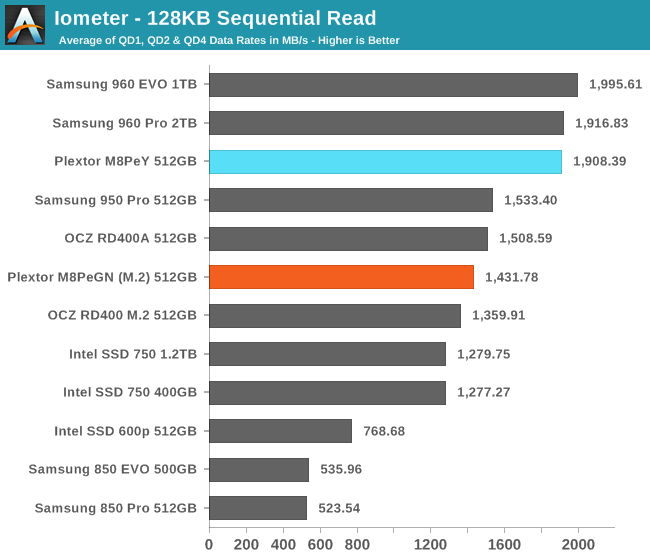
The heatsink makes a big difference for sequential read speeds: the M8PeY is essentially tied with the Samsung 960 Pro and EVO (both of which have the advantage of higher capacity). Without the heatsink, the M8PeGN delivers average performance for MLC-based PCIe SSDs.
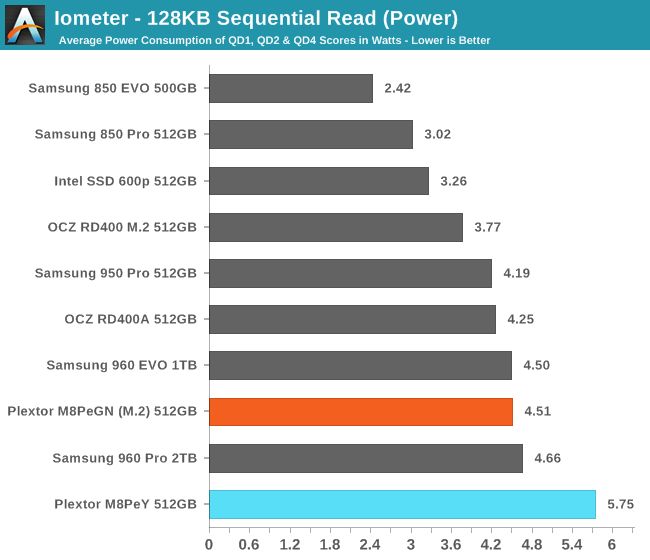
The M8PeY with its large heatsink (and LEDs) draws significantly more power than any of the M.2 PCIe SSDs to deliver top-notch performance. Without the heatsink (but with thermal throttling) the M8PeGN is still one of the most power-hungry drives. Neither configuration offers great efficiency.
 |
|||||||||
The sequential read performance of the M8Pe saturates at QD4 when the heatsink is used, but without the heatsink it is thermally limited for almost all of the test.
Sequential Write Performance
The sequential write test writes 128kB blocks and tests queue depths ranging from 1 to 32. The queue depth is doubled every three minutes, for a total test duration of 18 minutes. The test spans the entire drive, and the drive is filled before the test begins. The primary score we report is an average of performances at queue depths 1, 2 and 4, as client usage typically consists mostly of low queue depth operations.
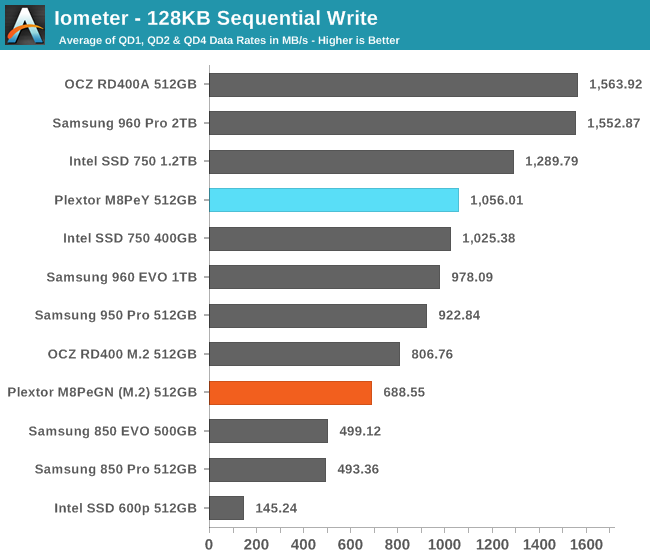
As with random writes and sequential reads, the heatsink makes a big difference for sustained sequential writes. Without the heatsink, the M8Pe's high power consumption leads to enough thermal throttling that it is the slowest MLC PCIe SSD in the bunch, but still substantially faster than SATA. With the heatsink, speeds are over 50% faster and the M8Pe is on par with the Intel SSD 750.
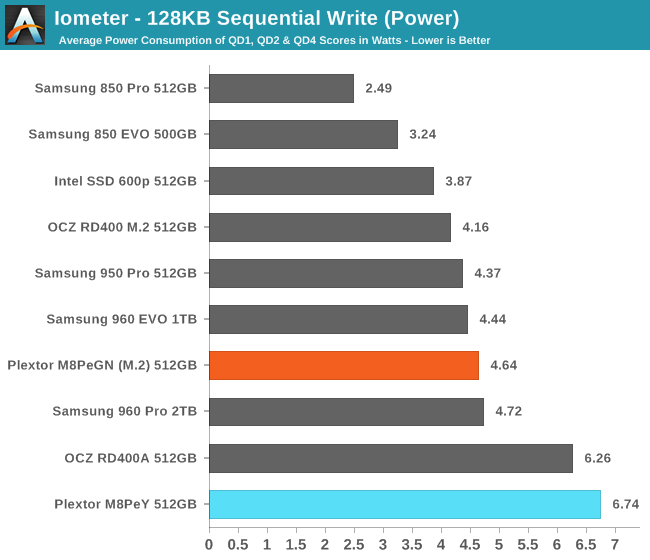
The power consumption situation is very similar to what we saw on the sequential read test. The thermally-limited M8PeGN draws a similar amount of power to the Samsung 960 Pro, while the M8PeY draws much more, and neither wins a prize for efficiency.
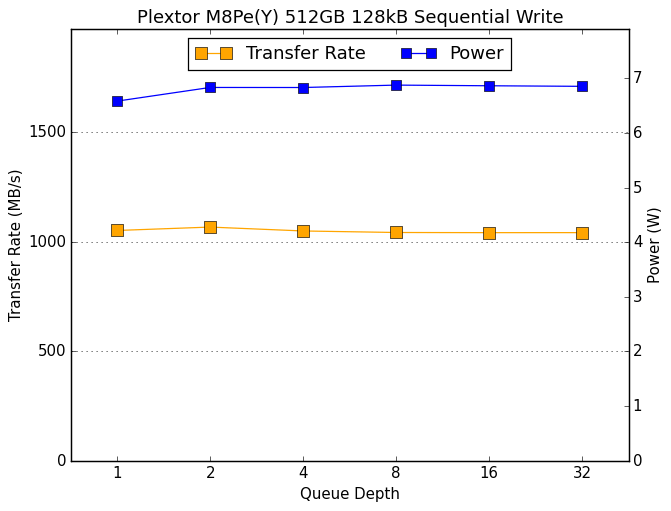 |
|||||||||
Without a heatsink, thermal throttling starts very early on this test, but the M8PeGN gets in enough of a burst at the beginning to have a noticeably better average at QD 1 than later in the test. With the heatsink, the M8PeY shows mostly flat performance across the entire duration of the test.










64 Comments
View All Comments
close - Friday, December 16, 2016 - link
I'm not at all sure how dire the shortage is but there's plenty of online material for this. Of course, the titles might be apocalyptic but you can get a sense that it's not something to shrug off quite yet:http://www.digitimes.com/news/a20161212VL201.html
http://www.tomshardware.co.uk/ssd-hdd-shortage-nan...
https://www.custompcreview.com/news/nand-flash-pri...
https://epsnews.com/2016/10/12/supply-shortage-nan...
And this fits perfectly with the price trends for some SSDs. Crucial/Micron is a nice holdout but probably because of the in-house NAND manufacturing.
On a slightly unrelated note, while I consider Samsung's drives to deliver the highest performance (and use them because of this), I wouldn't say they are most balanced because of the price and implicitly the price/performance ratio. I still go with SanDisk and Crucial wherever top range performance isn't critical because I think they offer a lot more value.
jabber - Friday, December 16, 2016 - link
There is always a 'shortage' yet life and sales go on. Just market FUD too manipulate prices. Never seems to push through to retail much.shabby - Thursday, December 15, 2016 - link
Seems like you guys should be comparing every capacity of ssd when doing reviews, if samsung sends you only the 1tb version tell them where are the other two, because clearly they will be slower.Mr Perfect - Thursday, December 15, 2016 - link
Yes, and this could be played the other way, too. When Plextor sends in a 512GB drive, let them know that they'll be benched against a 1TB Samsung and will be at a disadvantage.Bruce427 - Friday, December 16, 2016 - link
The reason for the 1TB Samsung 960 EVO (only) is, at the time that 's all Samsung was shipping. I'm sure reviews on other models will follow soon.Billy Tallis - Thursday, December 15, 2016 - link
In the specific case of the 960 EVO, Samsung sent me a 1TB and a 250GB sample. The 250GB died, but I'm currently writing up the review of the replacement.Most of the companies and PR people I deal with are very understanding of my desire to test the full range of capacities. But for many product launches, the PR departments simply don't get enough supply to satisfy us reviewers. I can't even say that the executives several levels up who make those allocation decisions are wrong. Most of their benefit comes from the initial exposure of having the SSD reviewed at all. Providing a wider range of samples means they'll get mentioned more frequently as a point of comparison in future reviews, but that's a tough sell when it means a retailer like Newegg is more likely to run out before their second shipment comes in.
Some companies have indicated that they'd be open to providing further samples post-launch when supply is no longer constrained. But I'm not in a good position to ask for that when I still have a backlog of drives that haven't gotten a first review.
epobirs - Friday, December 16, 2016 - link
Also, don't be fooled by MSRP. I got the bare version of the Plextor for under $200 from Newegg recently. I wouldn't have been able to justify going PCIe with any other product I examined at the time.aeolist - Wednesday, December 14, 2016 - link
The 512GB M8Pe was $180 on Newegg over Black Friday, which made it a pretty easy choice for me. Keep an eye out over the holidays, I wouldn't be surprised to see it and the RD400 go on sale pretty significantly.icrf - Wednesday, December 14, 2016 - link
I did the same thing. And to clarify, it was the GN model, without the heat spreader. Aside from having a difficult time getting my Linux install copied over and booting properly, been happy with it, but haven't really stressed it yet.sinPiEqualsZero - Wednesday, December 14, 2016 - link
From a real-world perspective, are we at the point where we (meaning "the majority of humans") can tell the difference between an M.2 PCI-E and SATA drive during normal usage?I ask because I'm using a 1 GB ADATA drive that I picked up for $220 last year and it was a decent upgrade over my Crucial M4. I wonder if the jump from SATA to PCI-E is likewise noticeable.